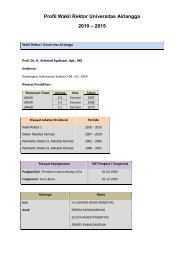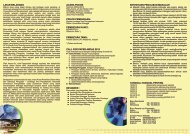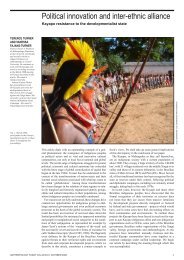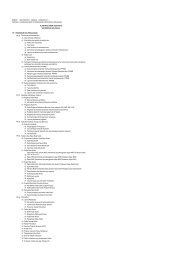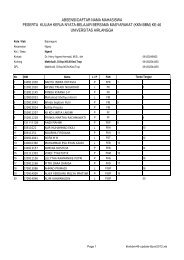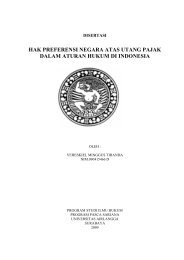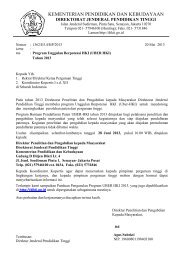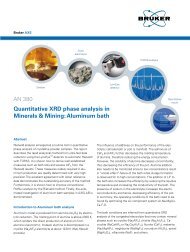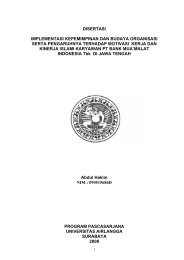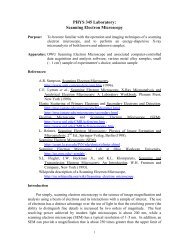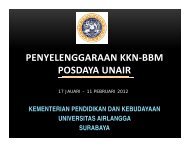Medicinal properties of mangosteen (Garcinia mangostana)
Medicinal properties of mangosteen (Garcinia mangostana)
Medicinal properties of mangosteen (Garcinia mangostana)
You also want an ePaper? Increase the reach of your titles
YUMPU automatically turns print PDFs into web optimized ePapers that Google loves.
3236 J. Pedraza-Chaverri et al. / Food and Chemical Toxicology 46 (2008) 3227–3239<br />
receptors in rat basophilic leukemia RBL-2H3 cells. These authors<br />
suggest that the inhibitory mechanism <strong>of</strong> degranulation by xanthones<br />
was mainly due to suppression <strong>of</strong> the SYK/PLCcs/PKC<br />
pathway.<br />
All the data above indicate that xanthones isolated from <strong>mangosteen</strong><br />
could be a novel target <strong>of</strong> anti-inflammatory and antiallergic<br />
compounds.<br />
4.4. Antibacterial, antifungal and antiviral <strong>properties</strong><br />
Several studies have demonstrated antibacterial, antifungal and<br />
antiviral <strong>properties</strong> <strong>of</strong> xanthones and extracts obtained from GML<br />
(Tables 10 and 11).<br />
Sundaram et al. (1983) studied the antibacterial and antifungal<br />
<strong>properties</strong> <strong>of</strong> a-mangostin and four <strong>of</strong> its derivatives. They found<br />
that bacteria S. aureus, P. aeruginosa, Salmonella typhimurium and<br />
Bacillus subtilis were highly susceptible to xanthones, whereas Proteus<br />
sp., Klebsiella sp. and Escherichia coli were only moderately susceptible<br />
to them. About fungi, Epidermophyton floccosum, Alternaria<br />
solani, Mucor sp., Rhizupus sp. and Cunninghamella echinulata were<br />
also highly susceptible to xanthones, whereas Trichophyton mentagrophytes,<br />
Microsporum canis, Aspergillus niger, Aspergillus flavus,<br />
Penicillium sp., Fusarium roseum and Curvularia lunata were only<br />
moderately susceptible to them. The minimum inhibitory concentration<br />
(MIC, the lowest concentration <strong>of</strong> an antimicrobial that will<br />
inhibit the visible growth <strong>of</strong> a microorganism after overnight incubation)<br />
<strong>of</strong> a-mangostin was between 12.5 and 50 lg/mL for bacteria<br />
and between 1 and 5 lg/mL for fungi. The order <strong>of</strong> the<br />
antibacterial and antifungal efficiency was as follows: a-mangostin<br />
> isomangostin > 3-O-methyl mangostin > 3,6-di-O-methyl<br />
mangostin. Mangostin triacetate had no activity.<br />
Mahabusarakam et al. (1986) investigated the antimicrobial<br />
activities <strong>of</strong> mangostin, gartanin, c-mangostin, 1-isomangostin<br />
and 3-isomangostin isolated from GML against S. aureus, both normal<br />
and penicillin-resistant strains. The order <strong>of</strong> the efficacy deter-<br />
Table 10<br />
Antibacterial <strong>properties</strong> <strong>of</strong> G. <strong>mangostana</strong><br />
mined by the MIC (lg/mL) was found to be methicillin (3.9) > amangostin<br />
(15.6) > c-mangostin (31.2) > 1-isomangostin (62.5) ><br />
3-isomangostin (125) > gartanin (250) against normal strain, and<br />
for penicillin-resistant strains a-mangostin (1.56–12.5) > methicillin<br />
(1.56–12.5) > 1-isomangostin (125) > 3-isomangostin (250), cmangostin<br />
(250) and gartanin (250). In addition, the activities <strong>of</strong><br />
mangostin, gartanin and c-mangostin against Candida albicans,<br />
Cryptococcus ne<strong>of</strong>ormans, T. mentagrophytes and Microsporum gypseum<br />
were tested. All <strong>of</strong> the components showed moderate activities<br />
against T. mentagrophytes and M. gypseum but exhibited no<br />
activity against C. albicans and C. ne<strong>of</strong>ormans.<br />
Iinuma et al. (1996) studied the inhibitory effect <strong>of</strong> several xanthones,<br />
isolated from <strong>mangosteen</strong>-fruit pericarp, against the growth<br />
<strong>of</strong> methicillin-resistant S. aureus (MRSA). a-mangostin exhibited<br />
high efficacy, with MIC values <strong>of</strong> 1.57–12.5 lg/mL.<br />
Chanarat et al. (1997) found that polysaccharides obtained from<br />
<strong>mangosteen</strong>-fruit pericarp can stimulate activity <strong>of</strong> polymorphonuclear<br />
phagocytic cells against Salmonella enteritidis.<br />
Suksamrarn et al. (2003) studied the antituberculosis potential<br />
<strong>of</strong> prenylated xanthones obtained from <strong>mangosteen</strong>-fruit pericarp.<br />
Among them a-, and b-mangostins and garcinone B exhibited the<br />
most potent inhibitory effect against Mycobacterium tuberculosis,<br />
with an MIC <strong>of</strong> 6.25 lg/mL; whereas demethylcalabaxanthone<br />
and trapezifolixanthone had an MIC value <strong>of</strong> 12.5 lg/mL and cmangostin,<br />
garcinone D, mangostanin, mangostenone A and tovophyllin<br />
B had an MIC value <strong>of</strong> 25 lg/mL. The xanthones with low<br />
antituberculosis potential were mangostenol and mangostanol<br />
with MIC values <strong>of</strong> 100 lg/mL and 200 lg/mL, respectively.<br />
Chomnawang et al. (2005) evaluated the antibacterial activity<br />
<strong>of</strong> 19 medicinal plants from Thailand against Staphylococcus epidermidis<br />
and Propionibacterium acnes, which have been recognized as<br />
pus-forming bacteria triggering an inflammation in acne. Only 13<br />
Thai medicinal plants were able to inhibit the growth <strong>of</strong> both bacteria.<br />
Among these, GML exhibited the most potent inhibitory effect,<br />
with an MIC value <strong>of</strong> 0.039 lg/mL for both bacteria.<br />
Effect References<br />
a-Mangostin strongly inhibited S. aureus, P. aeruginosa, S. thypimurium, B. Subillis Sundaram et al. (1983)<br />
It was showed the antibacterial activity <strong>of</strong> the a- and c-mangostins in 49 species <strong>of</strong> methicillin-resistant Staphylococcus aureus (MRSA)<br />
and the antibacterial activity <strong>of</strong> a-mangostin in 50 species <strong>of</strong> MRSA and 13 species <strong>of</strong> Enterococcus spp.<br />
Phongpaichit et al. (1994)<br />
Six xanthones including a-mangostin, garcinone E, gartanin, and c-mangostin showed antibacterial activity against MRSA Iinuma et al. (1996)<br />
Polysaccharides form the pericarp <strong>of</strong> GML enhanced the ability <strong>of</strong> phagocytic cells to kill Salmonella enteritidis in vitro Chanarat et al. (1997)<br />
a and c-mangostins and garcinone B exhibited strong inhibitory effect against Mycobacterium tuberculosis Suksamrarn et al. (2003)<br />
Extract <strong>of</strong> GML ihibited the growth <strong>of</strong> Propionibacterium acnes and Staphylococcus epidermidis Chomnawang et al. (2005)<br />
a-Mangostin is active against vancomycin resistant Enterococci (VRE) and MRSA Sakagami et al. (2005)<br />
Ethanolic extracts <strong>of</strong> GML inhibited MRSA and S. aureus ATCC25923 Voravuthikunchai and Kitpipit<br />
(2005)<br />
The herbal mouthwash containing the pericarp extract <strong>of</strong> GML may be used as an adjunct in treating oral malodor Rassameemasmaung et al.<br />
(2007)<br />
Table 11<br />
Antifungal and antiviral <strong>properties</strong> <strong>of</strong> G. <strong>mangostana</strong><br />
Effect References<br />
a-Mangostin showed antifungal activity against Epidermdophyton floccosum. Alternaria solani, Mucor sp., Rhizopus sp., Cunninghamella Sundaram et al. (1983)<br />
echinulata<br />
a-Mangostin, gartanin, c-mangostin, 1-isomangostin and 3-isomangostin showed activity against Staphylococcus aureus both normal Mahabusarakam et al. (1986)<br />
and penicilline-resistan strains. Mangostin, c-mangostin and gartanin showed moderate activities against Trichophyton<br />
mentagrophytes and Microsporum gypseum<br />
Ethanolic extract <strong>of</strong> GM, and a and b-mangostins have a potent inhibitory activity against HIV-1 protease (proteolytic cleavage) Chen et al. (1996) and Vlietinck et al.<br />
(1998)<br />
a-mangostin, BR-xanthone A, gartanin, 8-deoxygartanin, garcinone D, c-mangostin, and euxanthone showed antifungal activity Gopalakrishnan et al. (1997)<br />
against F. oxysprum vasinfectum, A. tenuis, and D. oryzae<br />
Gopalakrishnan et al. (1997) demonstrated that A and B rings <strong>of</strong> xanthones are important to antifungal activity.



